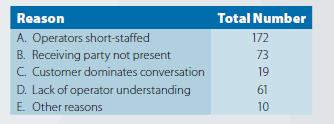Welz Business Machines sells and services a variety of copiers, computers, and other office equipment. The company
Question:
Welz Business Machines sells and services a variety of copiers, computers, and other office equipment. The company receives many calls daily for service, sales, accounting, and other departments. All calls are handled centrally through customer service representatives and routed to other individuals as appropriate. A number of customers have complained about long waits when calling for service. A market research study found that customers become irritated if the call is not answered within five rings. Scott Welz, the company president, authorized the customer service department manager, Tim, to study this problem and find a method to shorten the call-waiting time for its customers. Tim met with the service representatives to attempt to determine the reasons for long waiting times. The following conversation ensued:
Tim: “This is a serious problem; how a customer phone inquiry is answered is the first impression the customer receives from us. As you know, this company was founded on efficient and friendly service to all our customers. It’s obvious why customers have to wait: you’re on the phone with another customer. Can you think of any reasons that might keep you on the phone for an unnecessarily long time?”
Robin: “I’ve noticed that quite often the party I need to route the call to is not present. It takes time to transfer the call and then wait to see if it is answered. If the party is not there, I end up apologizing and have to transfer the call to another extension.”
Tim: “You’re right, Robin. Sales personnel often are out of the office for sales calls, absent on trips to preview new products, or not at their desks for a variety of reasons. What else might cause this problem?”
Ravi: “I get irritated at some customers who spend a great deal of time complaining about a problem that I cannot do anything about except refer to someone else. Of course, I listen and sympathize with them, but this eats up a lot of time.”
LaMarr: “Some customers call so often, they think we’re long-lost friends and strike up a personal conversation.”
Tim: “That’s not always a bad thing, you realize.”
LaMarr: “Sure, but it delays my answering other calls.”
Nancy: “It’s not always the customer’s fault. During lunch times, we’re not all available to answer the phone.”
Ravi: “Right after we open at 9:00 a.m., we get a rush of calls. I think that many of the delays are caused by these peak periods.”
Robin: “I’ve noticed the same thing between 4:00 and 5:00 p.m.”
Tim: “I’ve had a few comments from department managers that they received routed calls that didn’t fall in their areas of responsibility and had to be transferred again.”
Mark: “But that doesn’t cause delays at our end.”
Nancy: “That’s right, Mark, but I just realized that sometimes I simply don’t understand what the customer’s problem really is. I spend a lot of time trying to get him or her to explain it better. Often, I have to route it to someone because other calls are waiting.”
Ravi: “Perhaps we need to have more knowledge of our products.”
Tim: “Well, I think we’ve covered most of the major reasons as to why many customers have to wait. It seems to me that we have four major reasons: the phones are shortstaffed, the receiving party is not present, the customer dominates the conversation, and you may not understand the customer’s problem. We need to collect some information next about these possible causes. I will set up a datacollection sheet that you can use to track some of these things. Mark, would you help me on this?” Over the next two weeks, the staff collected data on the frequency of reasons why some callers had to wait:

Case Questions for Discussion:
1.From the conversation between Tim and his staff, draw a cause-and-effect diagram.
2.Perform a Pareto analysis of the data collected.
3.What actions might the company take to improve the situation?
Step by Step Answer:

Operations And Supply Chain Management
ISBN: 9780357901649
3rd Edition
Authors: David A. Collier; James Evans





